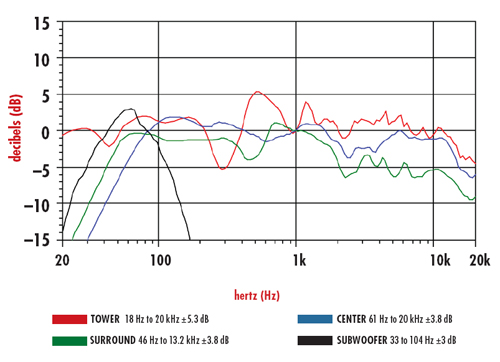Monitor Audio Silver RX Series Speaker System Page 3

TEST BENCH
Frequency response (at 2 meters)
tower 18 Hz to 20 kHz ±5.3 dB
center 61 Hz to 20 kHz ±3.8 dB
surround 46 Hz to 13.2 kHz ±3.8 dB
subwoofer 33 to 104 Hz ±3 dB
Sensitivity (SPL at 1 meter with 2.8 volts of pink-noise input)
tower 88 dB
center 89 dB
surround 86 dB
Impedance (minimum/nominal)
tower 3.9/6 ohms
center 3.0/5 ohms
surround 4.8/8 ohms
Bass limits (lowest frequency and maximum SPL with limit of 10% distortion at 2 meters)
tower 50 Hz at 81 dB
center 50 Hz at 76 dB
surround 63 Hz at 84 dB
subwoofer: 20 Hz at 81 dB SPL
92 dB average SPL from 25 to 63 Hz
102 dB maximum SPL at 50 Hz
bandwidth uniformity 89%
All of the frequency-response curves shown in the graph above are weighted to reflect how sound arrives at a listener's ears in a typical listening room with normal speaker placement. Measurements were made at 2 meters so that full effects of cabinet diffraction and front-panel reflections were included. The RX6 tower speaker was measured standing on the ground, which is the way it will always be used. The RX Centre speaker was measured atop a 6-foot-high stand. The RXFX surround speaker was measured mounted on a plywood panel to simulate the effects of wall-mounting. These tests gave quasi-anechoic results down to about 200 Hz in the case of the RX Centre and RXFX, and 150 Hz in the case of the RX6. Response of woofers was close-miked, summed with the ports if applicable, and spliced to the quasi-anechoic response. The subwoofer's driver was close-miked. All of the measurements shown in the graph were taken with the speaker grilles removed.
Like almost all tower speakers, the RX6 shows the acoustical effect of the floor in front of it: a dip of about 5 dB centered at 300 Hz with a corresponding peak centered at 500 Hz. Otherwise, though, it measures fairly well, with a response of ±2.5 dB between 660 Hz and 13.5 kHz. As with all the speakers in the line, there's a gentle treble rolloff. Bass response of this slim speaker is very deep, dropping all the way down to 18 Hz, but the output at such low frequencies is timid and distorted. Still, in some ways its bass response beats the subwoofer's. Off-axis response is great, with nothing but the expected slight rolloff below 8 kHz; it gets a little more random above that, but those frequencies aren't terribly audible. The grille rolls off the treble a bit more above about 8 kHz, and adds a couple of treble dips in the 4–-to-6-kHz range.
As you can gauge from the graph, the RX Centre matches the tower speaker's timbre well. However, its response is not symmetrical because the two woofers have different responses (probably due to intentional filtering in the crossover). The off-axis response is pretty random, with some severe cancellation effects at 15° and 30°, but it all averages out well. As with the RX6, the grille causes a slight upper treble rolloff and a few dips in the lower treble.
The RXFX surround measures almost identically in bipolar and dipolar modes. (The former is shown in the graph.) It shows a dip at 450 Hz and a peak at 700 Hz, both of which are due to wall-mounting. Its response is smooth for a bipole/dipole surround speaker.
Impedance of the RX6 is a little low but not low enough to cause problems for any decent receiver or amp; minimum is 3.9 ohms at 150 Hz. The RX Centre's impedance is a little more demanding, with a low of 3.0 ohms at 200 Hz. The RXFX is easy to drive, with a 4.8-ohm minimum impedance at 2.6 kHz, and a nominal impedance of 8 ohms. Sensitivity of all speakers is about average.
The RXW-12 has an old-school "haystack" response curve typical of 1990s subwoofers. Its output is concentrated between 50 and 60 Hz. While it does surprise with some clean output down to 20 Hz - a rarity for a sub of this size - the output falls off about 11 dB by 40 Hz, and another 10 dB or so below that. All of these measurements were taken in EQ1 mode. EQ2 mode boosts the deep bass by 7.3 dB at 20 Hz, but it doesn't increase the undistorted output. The combination of the low-pass filter and the acoustic rolloff of the driver yields a slope of about -21 dB/octave.














































